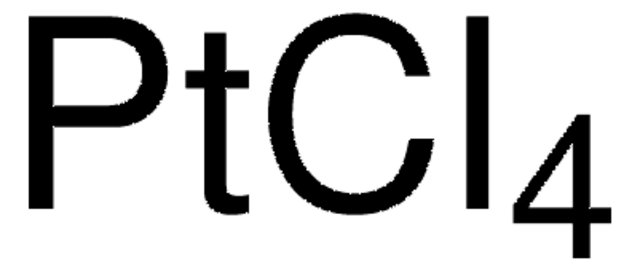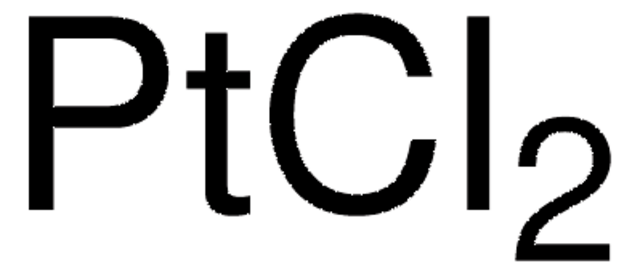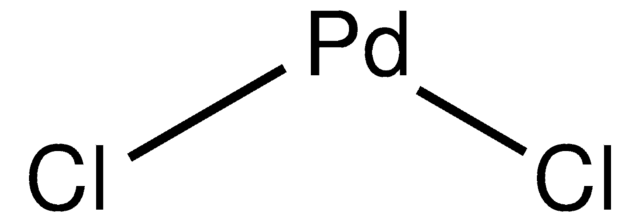379840
Platinum(IV) chloride
≥99.99% trace metals basis
Sinonimo/i:
Platinum tetrachloride
About This Item
Prodotti consigliati
Grado
for analytical purposes
Livello qualitativo
Saggio
≥99.99% trace metals basis
Stato
powder and chunks
Impiego in reazioni chimiche
reagent type: catalyst
core: platinum
Impurezze
≤100.0 ppm Trace Metal Analysis
Punto di fusione
370 °C (dec.) (lit.)
Densità
4.303 g/mL at 25 °C (lit.)
Stringa SMILE
Cl[Pt](Cl)(Cl)Cl
InChI
1S/4ClH.Pt/h4*1H;/q;;;;+4/p-4
FBEIPJNQGITEBL-UHFFFAOYSA-J
Cerchi prodotti simili? Visita Guida al confronto tra prodotti
Descrizione generale
Applicazioni
- As a precursor to synthesize Pt nanoparticles for photocatalytic hydrogen generation.
- As a starting material to prepare Pt/Al2O3 and Pt/ZrO2-SiO2 catalysts.
- To fabricate an electrocatalyst for proton exchange fuel cells.
- As a catalyst for the cyclization of arene−alkynesubstrates via intramolecular electrophilic hydroarylation.
Avvertenze
Danger
Indicazioni di pericolo
Classi di pericolo
Acute Tox. 3 Oral - Eye Dam. 1 - Resp. Sens. 1 - Skin Corr. 1B - Skin Sens. 1
Codice della classe di stoccaggio
6.1A - Combustible acute toxic Cat. 1 and 2 / very toxic hazardous materials
Classe di pericolosità dell'acqua (WGK)
WGK 2
Punto d’infiammabilità (°F)
Not applicable
Punto d’infiammabilità (°C)
Not applicable
Dispositivi di protezione individuale
Eyeshields, Faceshields, Gloves, type P3 (EN 143) respirator cartridges
Scegli una delle versioni più recenti:
Possiedi già questo prodotto?
I documenti relativi ai prodotti acquistati recentemente sono disponibili nell’Archivio dei documenti.
I clienti hanno visto anche
Articoli
Plasmonic nanoparticles have unique optical properties that can be tailored to suit a variety of applications in the biotechnology1–8 and electronics9–16 industries.
Il team dei nostri ricercatori vanta grande esperienza in tutte le aree della ricerca quali Life Science, scienza dei materiali, sintesi chimica, cromatografia, discipline analitiche, ecc..
Contatta l'Assistenza Tecnica.















